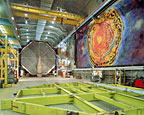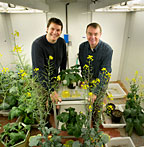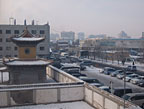- Number 365 |
- June 18, 2012
-
Gelatin helps foam pull radioactive contaminants from building structures
 Researchers looking for a new fix to a stubborn problem have found a solution in good old-fashioned gelatin. The stuff of colorful childhood treats provides the rigidity required for a new type of foam that can stick fast to walls or ceilings.
Researchers looking for a new fix to a stubborn problem have found a solution in good old-fashioned gelatin. The stuff of colorful childhood treats provides the rigidity required for a new type of foam that can stick fast to walls or ceilings.
So why would anyone care about a rigid, gelatin-laced foam? Because the technology can leach radioactive particles or toxic metals from contaminated surfaces more quickly and cheaply than traditional methods.
Radioactive contamination can be difficult to remediate. Removing contamination from complex surfaces such as brick or concrete can be costly, inefficient and hazardous. But the new approach developed at DOE's Idaho National Laboratory is changing that. -
Scientists take a giant step forward in understanding plutonium
Nuclear magnetic resonance offers new insights into the element
Plutonium is the most complex element in the periodic table, yet it is also one of the most poorly understood ones. But now a well-known scientific technique, nuclear magnetic resonance (NMR) spectroscopy, may turn out to be the perfect tool for uncovering some of plutonium’s mysteries. Scientists at DOE's Los Alamos National Laboratory (LANL) and the Japan Atomic Energy Agency (JAEA) have detected the faint signal of plutonium-239’s unique nuclear magnetic resonance signature.
This signal promises to become a Rosetta stone for deciphering the complex atomic-scale electronic properties of this perplexing element. Their paper on the subject, "Observation of 239Pu Nuclear Magnetic Resonance," was published in the May 18 issue of Science magazine.. -
Feedback regulates plant oil production
Scientists at DOE's Brookhaven Lab have identified key elements in the biochemical mechanism plants use to limit the production of fatty acids. The results suggest ways they might target those biochemical pathways to increase the production of plant oils as a renewable resource for biofuels and industrial processes.
“There were hints that a feedback system might exist for plant oil production,” said Brookhaven biochemist John Shanklin, leader of the group publishing the work in the Proceedings of the National Academy of Sciences the week of June 4, 2012. He credits Carl Andre — a former postdoctoral research fellow now working at BASF Plant Science in North Carolina — with designing and carrying out the intricate biochemical detective work that uncovered the details. -
Berkeley Lab scientists tackle air pollution in Mongolia
Windswept Ulaan Bataar, the capital of Mongolia, is one of the most polluted cities in the world. Much of the problem can be traced to the coal-burning stoves used for heating and cooking in the city’s common form of housing, the round, tent-like structures called gers.
Ashok Gadgil, director of the Environmental Energy Technologies Division (EETD) at DOE’s Lawrence Berkeley National Laboratory, is well known for his high-efficiency cookstoves used in the refugee camps of Darfur and in Ethiopia and Haiti. Now Gadgil and his colleagues are working with the Millennium Challenge Corporation (MCC), a U.S. foreign aid agency, to improve air quality in Mongolia’s capital city by lowering emissions from outdated stoves and boilers. A small team of EETD scientists led by Maithili Iyer and Larry Dale, working with MCC through the DOE, has traveled to Mongolia to lend technical guidance to implement the new stove program and evaluate it. -
Desert dust intensifies summer rainfall in U.S. southwest
Dust kicked up from the desert floor acts like a heat pump in the atmosphere, fueling the annual climate system called the North American Monsoon, according to scientists at DOE’s Pacific Northwest National Laboratory. The dust increases precipitation by up to 40 percent during the summer rainy season in Arizona, New Mexico and Texas. Their study, the first on the U.S. Southwest summer monsoon, found that the heat pump effect, attracting moisture from nearby oceans and increasing seasonal rainfall, is consistent with how dust acts on West African and Asian monsoon regions.






